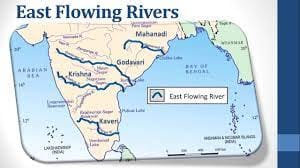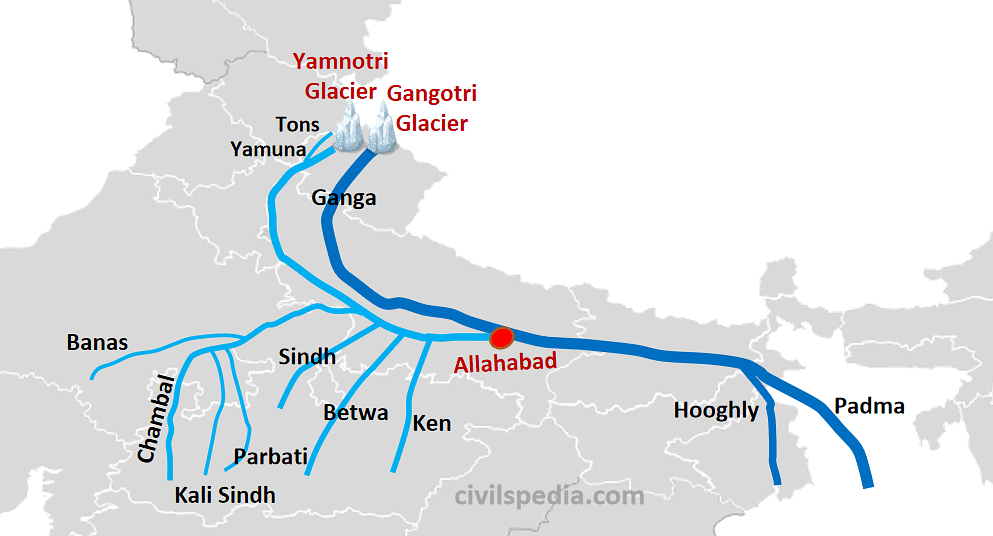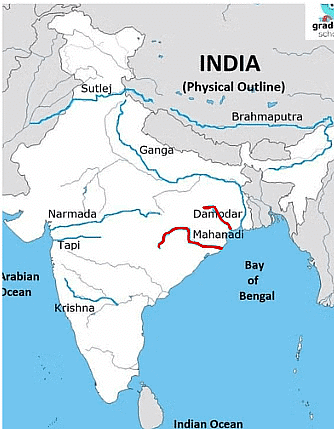The Southern Plateaus Class 4 Notes SST
Plateaus
Have you ever seen a hill? It's a big, tall land formation that goes up high. But what about something that's not as big as a hill but still has some height? It's not flat like a plain, either. Well, that's where a plateau comes in! PlateauA plateau is like a "hill-like" thing, but not as big as a hill. It's a land area that is higher than the surrounding flat plains but not as high as a mountain. Picture a big, flat, or gently sloping surface that's raised up above the ground around it. It's like a giant, raised platform!
PlateauA plateau is like a "hill-like" thing, but not as big as a hill. It's a land area that is higher than the surrounding flat plains but not as high as a mountain. Picture a big, flat, or gently sloping surface that's raised up above the ground around it. It's like a giant, raised platform! Plateau lands are special places on Earth. They are like flat areas but on a raised platform. The surface of a plateau is not smooth like a plain. It has rough and uneven slopes. That's why some people also call plateaus "Table Lands" because they look like giant tables.
Plateau lands are special places on Earth. They are like flat areas but on a raised platform. The surface of a plateau is not smooth like a plain. It has rough and uneven slopes. That's why some people also call plateaus "Table Lands" because they look like giant tables.
 Image Caption
Image Caption
What are the Southern Plateaus?
In India, there are flat lands called plateaus located to the south of the northern plains. On the sides of these plateaus, there are hilly areas known as the Ghats.
- The Aravalli Ranges are in the northwest of the Southern Plateau region, and in the northeast are the Rajmahal Hills.
- The Southern Plateaus have a shape like a triangle. Kanyakumari marks the very bottom tip of the land and also the southern part of the plateau region.
- The Narmada River flows through the plateau, splitting it into two parts. The northern part is called Central Highlands, while the southern part is known as the Deccan Plateau.
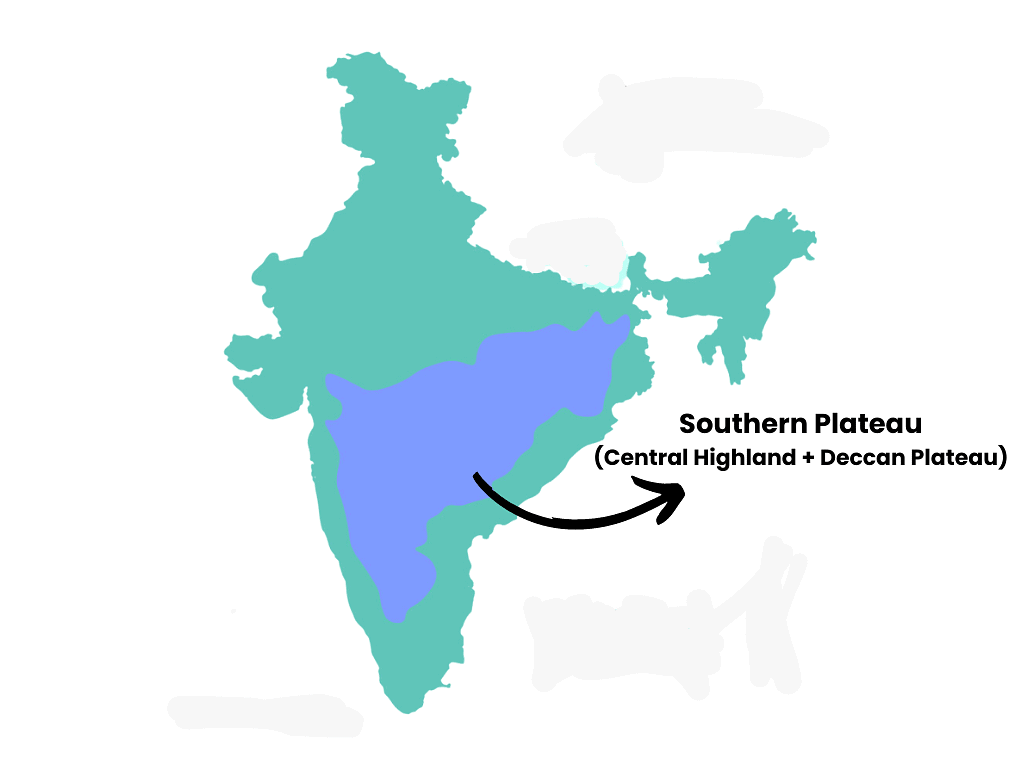 Southern Plateau shown on the map
Southern Plateau shown on the map
- The plateau is divided into two parts by the River Narmada. The part in the north is called the Central Highlands, and the part in the south is known as the Deccan Plateau. The Plateau region covers the largest part of India.
- When you look at the plateau, you will notice that it slopes from the west towards the east. The land surface is rocky and not smooth. It has a lot of bumps and uneven parts.
- The soil on the plateau is not very deep, which means it's not as fertile as other places. However, something interesting happens when the rivers flow through the plateau. They wash away the rocks and create valleys with better soil. These valleys are more fertile and suitable for farming.
Central Highlands
The Central Highlands are in the middle of the southern plateaus. They have two important plateaus. One is called the Malwa Plateau in the northwest, and the other is the Chotanagpur Plateau in the northeast.
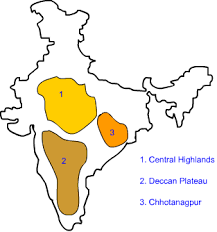
- They're bordered by different hill ranges and have a place called the Malwa Plateau in the middle. Many rivers from this area join bigger rivers like the Yamuna and Ganga.
- When water falls from a high place like a mountain or plateau, it makes a waterfall. An example is Jog Falls in Karnataka. Some rivers in this area are Chambal, Betwa, and Son.
- The Chota Nagpur Plateau is part of this region, covering places like Jharkhand and parts of Odisha and Chhattisgarh. It's rich in coal and minerals.
The Deccan Plateau
The Deccan Plateau stretches from the Narmada River down to the bottom of India.
- It's surrounded by the Western and Eastern Ghats, which meet at the Nilgiri Hills.
- Many rivers like the Godavari, Krishna, and Kaveri start from the Western Ghats and flow east.

- The Eastern Ghats are divided by rivers flowing from the Western Ghats, and most of these rivers flow into the Bay of Bengal.
- The longest river here is the Godavari.
Rivers Flowing in Plateau Region
A number of rivers flow through the Plateau region.
- Narmada and Tapti are the only two rivers that flow westward and join the Arabian Sea.
- Other rivers flow eastward and join the Bay of Bengal. Mahanadi, Godavari, Krishna, and Kaveri rise in the west. These are rain-fed rivers.

- Unlike the rivers rising from the Himalayas, these rivers dry up during the summer season. In cases of heavy rainfall, they are flooded.
- Chambal, Betwa, Ken, and Son rivers join the Yamuna and Ganga. These rivers have a northward flow. As the rivers go dry during the summer, there are no canal networks like in the northern plains.

- Irrigation in the Plateau region is mostly from tanks in which rainwater gets stored. A number of dams have been set up on the rivers to store water.
- The Godavari is the most sacred of all rivers in the South. It rises at Trimbak in Maharashtra.
- As the Ganga is to the people in the north, Kaveri is to the people in the south. It is also known as the Dakshina Ganga. Kaveri is the main river flowing through the State of Karnataka.
- The dam on the Krishna River is named Nagarjuna Sagar Dam. On the Southern Plateau, there are a number of waterfalls. The flowing river drops off the hill in a torrent.
 Nagarjuna Sagar Dam
Nagarjuna Sagar Dam
- River Sharavati forms the famous Jog Falls.


Climate in Plateau Region
The climate is neither very hot nor very cold. The temperatures do not show much difference over the years. Rainfall is low except in the western parts.
Minerals Found in the Plateau Region
A number of minerals are found, including mica, coal, iron and manganese.
- Mica is used as an insulator in electrical machines. It can stand heat and is not a conductor of electricity.
- River Damodar flows through the northeast. Most of India's coal is mined from the Damodar Valley.

- River Mahanadi has made the Chotanagpur Plateau a wide and fertile plain.
Vegetation in the Plateau Region
In between the Narmada and Krishna rivers lies the Central Plateau. The region is rich in black soil. The soil is very fertile and suited for the cultivation of cotton.
 Cotton Cultivation in India
Cotton Cultivation in India
- The River Chambal flows in the north-western Plateau region. The river has cut deep ravines, which were at one time the abode of many Dacoit gangs.
- The Plateau region is important for us in three ways. It has a rich store of minerals. There are forests that provide wood, teak, and sandalwood.
Cultural and Economic Significance
- There are tribal communities living in the Bastar region, and the Central Plateau between the Narmada and Krishna rivers has fertile black soil ideal for cotton cultivation.
- The region is also known for its forests that provide wood, teak, and sandalwood.
Overall, the plateau region is significant for its mineral wealth, forests, and fertile soil, making it a vital part of India's economy and culture.

Life in the Region
The southern plateaus cover many states like Madhya Pradesh, Chhattisgarh, Jharkhand, Odisha, Telangana, Andhra Pradesh, Tamil Nadu, Karnataka, and Maharashtra. These areas have a lot of valuable minerals like coal, iron, copper, and manganese, so mining is a big deal. People also do farming, growing crops like wheat, rice, millets, groundnuts, cotton, and sugarcane.
- Madhya Pradesh
- Farming and making mats are common jobs here.
- There are diamond mines in Panna, and cities like Indore, Bhopal, Gwalior, and Jabalpur are important for industries.

- There are national parks like Kanha and Bandhavgarh to protect tigers, and places like Pachmarhi, Sanchi, and Khajuraho attract tourists.
- Chhattisgarh
- Besides the minerals, tin is also found here.
- The state has lots of forests where people collect things like wood, tendu leaves, honey, and lac.

- Bhilai has a steel plant, and Saila is known for a folk dance called Saila.
- Jharkhand
- This state is rich in minerals, which has led to many industries in cities like Jamshedpur, Bokaro, Ranchi, and Dhanbad.

- People enjoy foods like litti-chokha and thekua, and Chhau is a popular dance.
- Netarhat is a place that tourists like to visit.
- This state is rich in minerals, which has led to many industries in cities like Jamshedpur, Bokaro, Ranchi, and Dhanbad.
- Telangana
- Hyderabad is a big city with industries like IT, automobiles, and pharmaceuticals. Most people here speak Telugu, and Kuchipudi is a popular dance.

- The state is known for bidri work.
- Hyderabad is a big city with industries like IT, automobiles, and pharmaceuticals. Most people here speak Telugu, and Kuchipudi is a popular dance.
- Karnataka
- Coffee and spices are grown here, and there are gold mines in Kolar. Bengaluru is a major city for the IT industry.

- Karnataka is famous for its sandalwood handicrafts, and people speak Kannada. Yakshagana is a popular dance-drama here.
- Coffee and spices are grown here, and there are gold mines in Kolar. Bengaluru is a major city for the IT industry.
- Maharashtra
- This state is famous for cotton and oranges.
- Cities like Mumbai and Pune are industrial hubs.

- There are big oil deposits under the sea near Mumbai, called Mumbai High.
- People speak Marathi, and they celebrate festivals like Ganesh Chaturthi. Lavani is a popular folk dance here.
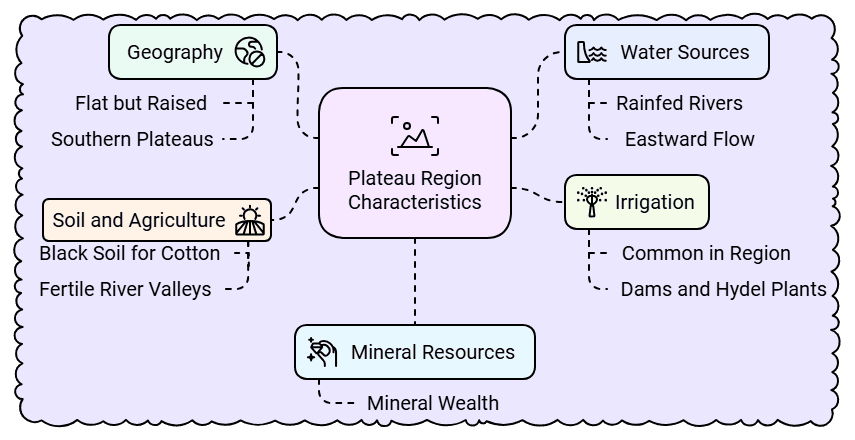 Image Caption
Image Caption
Things to Remember!
- Plateau lands are flat but on a raised platform.
- Plateau lands lie to the south of the northern plains. The southern Plateaus form the triangular south with Kanyakumari as the southernmost point.
- Rivers in the plateau region are rainfed and dry up in summer. Most rivers in the Plateau region flow eastwards.
- Tank irrigation is most common in the Plateau region.
- A number of dams have been built on the rivers to store water and run Hydel plants.
- The Plateau region is rich in minerals.
- The black soil of the valleys is most suited for the cultivation of cotton. Rice is also cultivated in the fertile river valleys.
|
47 videos|121 docs|42 tests
|
FAQs on The Southern Plateaus Class 4 Notes SST
| 1. What are the Southern Plateaus? |  |
| 2. Which rivers flow through the Plateau region? |  |
| 3. What is the climate like in the Plateau region? |  |
| 4. What minerals are found in the Plateau region? |  |
| 5. What is the cultural and economic significance of the Southern Plateaus? |  |

|
Explore Courses for Class 4 exam
|

|
